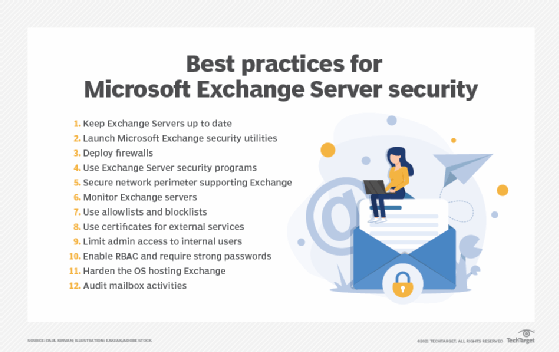Microsoft Exchange Online Protection (EOP)
What is Microsoft Exchange Online Protection (EOP)?
Microsoft Exchange Online Protection (EOP) is a cloud-based service that provides email filtering designed to protect organizations against spam, malware and other email-based threats. It is included with several Microsoft Office 365 plans and can also be purchased as a standalone service.
How does Microsoft Exchange Online Protection work?
Microsoft EOP works by analyzing inbound and outbound email messages and applying various filtering techniques to identify and block unwanted messages, helping organizations protect their email environments from a wide range of threats.
These filtering techniques include anti-spam and anti-malware protection as well as advanced threat protection features, such as URL filtering, dynamic delivery and time-of-click protection.
Besides email filtering, EOP provides email policy management features such as message and email archiving, which lets organizations enforce policies around the use of email and ensure that sensitive information is protected and retained for compliance.

What are Microsoft Exchange Online Protection's features?
Some of the key features of Microsoft EOP include the following:
- Anti-spam and anti-malware protection. EOP uses multiple filtering technologies to identify and block spam and malware before it reaches a business's email servers. This includes reputation-based filtering, content filtering and machine learning algorithms.
- Advanced threat protection. EOP advanced threat protection features include URL filtering, dynamic delivery and time-of-click protection to protect against sophisticated attacks such as phishing and ransomware.
- Data loss protection. DLP capabilities let businesses define policies for identifying and protecting sensitive information in email messages. DLP policies can be configured to prevent sensitive information from being sent outside of the organization to help protect against data breaches.
- Email encryption. Email encryption capabilities let businesses encrypt outbound email messages to protect against unauthorized access. Encryption can be applied automatically based on business policies or manually by users.
- Message tracking and reporting. Detailed message tracking and reporting capabilities help businesses monitor email traffic and identify potential security threats. This information can be used to improve security policies and identify areas for improvement.
These features are designed to be easy to use and can be customized to meet the specific security needs of each business.
How can a business use Microsoft Exchange Online Protection?
EOP is easy to set up and configure, making it an attractive option for businesses that want to quickly implement an email filtering and security solution.
It also integrates with other Microsoft cloud services, such as Exchange Online and Microsoft Defender for Office 365, providing a comprehensive security solution for organizations that use these services.
Some use cases include the following:
- Standalone email filtering and security. Businesses that use on-premises email servers or third-party email services can use EOP as a standalone email filtering and security solution. In this scenario, EOP is configured to filter inbound and outbound email messages for spam, malware and other email-based threats.
- Office 365 email filtering and security. Businesses that use Office 365 for their email service can use EOP as an integrated email filtering and security solution. EOP is included in many Office 365 plans and is automatically enabled when a business sets up their Office 365 account.
- Hybrid email environment. Businesses that use a hybrid email environment, with some users on-premises and others in the cloud, can use EOP to provide a consistent email filtering and security experience across both environments. EOP can be configured to filter email messages for both on-premises and cloud-based email users.
- Advanced threat protection. For additional protection against advanced email-based threats, such as phishing and ransomware, businesses can use EOP's advanced threat protection features.
Microsoft EOP can be used in a variety of scenarios to provide businesses with a email filtering and security solutions. But the specific configuration and deployment of EOP will depend on the business' email environment and unique security requirements.
Learn technical controls to prevent business email compromise attacks, see how to use business email compromise training to mitigate risk, and explore 5 business email compromise examples to learn from.






